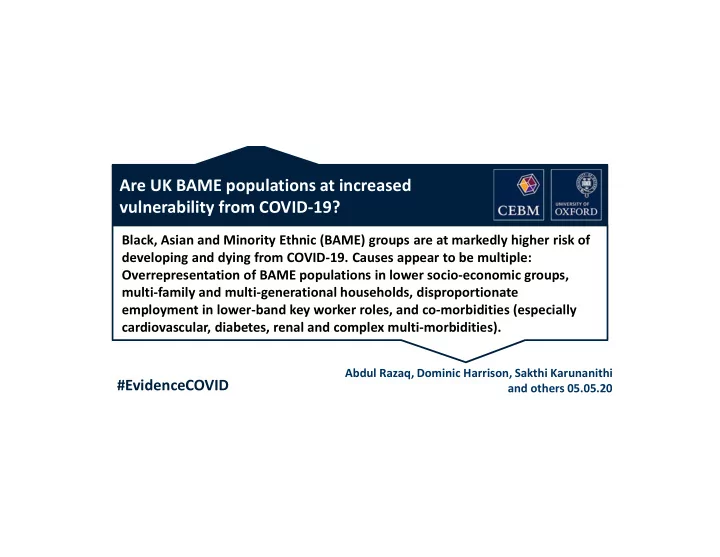

Are UK BAME populations at increased vulnerability from COVID-19? Black, Asian and Minority Ethnic (BAME) groups are at markedly higher risk of developing and dying from COVID-19. Causes appear to be multiple: Overrepresentation of BAME populations in lower socio-economic groups, multi-family and multi-generational households, disproportionate employment in lower-band key worker roles, and co-morbidities (especially cardiovascular, diabetes, renal and complex multi-morbidities). Abdul Razaq, Dominic Harrison, Sakthi Karunanithi #EvidenceCOVID and others 05.05.20
What do we know? • Anecdotal reports that large numbers of patients in hospital with COVID-19 are from Black, Asian and Minority Ethnic (BAME) communities. • BAME communities make up 14% of the population of England (ONS 2011). • BAME doctors make up 44% of all NHS doctors but 95% of deaths (HSJ, 22nd April 2020). • BAME nurses make up 20% of all NHS nurses but 71% of deaths (HSJ, 22nd April 2020). • Areas that have the most COVID-19 deaths (population adjusted) are the more ethnically diverse areas such as Newham, Harrow and Brent (ONS).
ONS individual level analysis results (full model) • Black people 1.9 times as likely to die of COVID-19. • Bangladeshi/Pakistani men 1.8 and women 1.6 times as likely to die of COVID-19.
Patient level data • OpenSAFELY study using patient level GP data for 17 million patients (7th May 2020). • Controls for host of socio-economic factors, health risk factors and co-morbidities. • Ethnicity has independent effect of similar magnitude to ONS data after controls. • Black people 1.7 and Asian people 1.6 times as likely to die as White population.
Number of cases • Exposure through employment e.g. NHS, precarious or zero hours contracts, front line jobs. • Exposure due to living conditions e.g. multi-generation household, higher housing density, more urban. • Exposure due to lack of effective design and communication of public health advice e.g. culture appropriate messaging. • Exposure due to inadequate testing and tracing. • All these factors would mean it is harder for BAME people to successfully lockdown so a higher BAME “R”. • More cases even if severity and treatment are the same will result in more deaths.
Severity of cases • Increased severity due to co-morbidities e.g. CVD, diabetes. • Increased severity due overcrowded housing resulting in higher viral load. • Increased severity associated with poor air quality and other environmental factors. • More severe cases even if equal numbers of cases and equal treatment will result in more deaths.
Treatment of cases • Conscious or unconscious bias in primary care interactions (111 or GP) e.g. leading to sub-optimal advice. • Worse treatment by ambulance service e.g. leading to later hospitalisation. • Worse treatment by hospitals leading to poorer treatment choices (DNR). • Poorer outcomes from interaction with health care system even if numbers and severity of cases are the same would result in more deaths.
Structural vs individual factors • more frontline roles and uptake of public health advice versus cultural differences result in increased isolation. • higher allostatic load versus vitamin D deficiency. • discrimination in 111/GP/Ambulance/Hospital versus reluctance to use healthcare. • Probably a mixture of causes any role found for individual factors should not conveniently obscure structural factors. • How do we unpick the causal effects of the various factors using the observational data available?
Risk Assessment for Staff • An independent advisory group to NHS England of clinical academics, Public Health and other doctors, led by Professor Kamlesh Khunti from Leicester University, reviewed the present evidence regarding the impact of COVID-19 on ethnic minority communities. • Now published on the NHS Employers and FOM website, view the BAME specific risk reduction paper.
Research Questions • What interventions exists to help mitigate these impacts in the immediate term? • Is it possible to unpick the causal effects of the various individual and structural factors using the observational data available? • What does the response to the disease both in clinical terms and in economic terms tell us about the implicit valuation of different lives - i.e. what do the policy choices made so far reveal about the societal exchange rate between Black lives and White lives - how does this compare across countries and correlate with other social values? • Do people voluntarily take on uncompensated risk or must power dynamics be included in economic studies. • Should we be conducting less simplistic epidemiological and economic analysis in order to understand the impact of policies on health inequalities rather than roll out policies that exacerbate these inequalities?
Recommend
More recommend